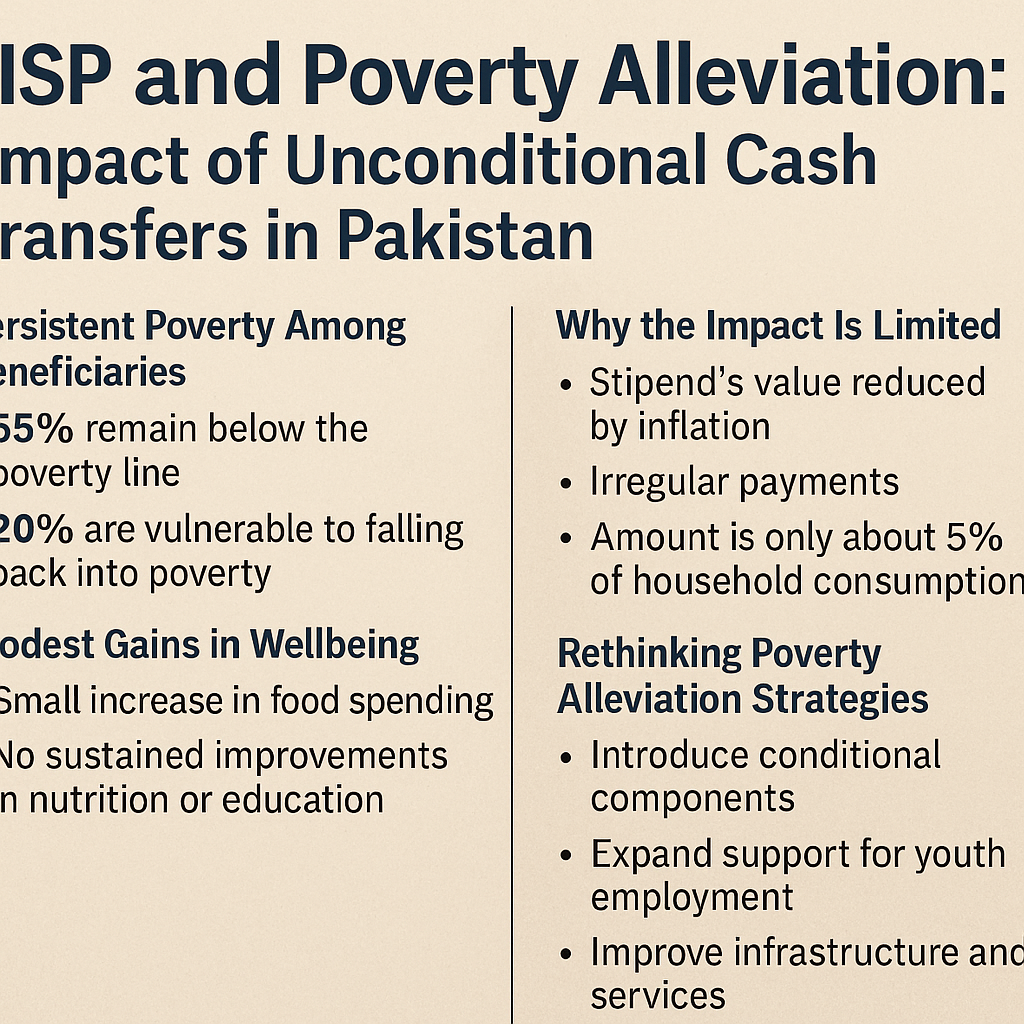BISP and Poverty Alleviation: Impact of Unconditional Cash Transfers in Pakistan

Pakistan’s flagship cash transfer program has been in place since 2008, providing quarterly payments to low-income households, primarily led by women. Over the years, the program has expanded to reach over 5 million families, with cash stipends increasing from Rs. 3,000 to Rs. 6,000 per quarter. This effort has contributed to raising the country’s total social protection spending from 0.1% of GDP in 2008 to nearly 2% by 2018.
Recent evaluations have looked at the long-term impact of these cash transfers on poverty alleviation and socioeconomic wellbeing. While the program has delivered some benefits, the overall impact on improving the lives of recipients appears limited.
Persistent Poverty Among Beneficiaries Despite receiving aid for several years, about 65% of recipient households remain below the poverty line. An additional 20% are considered vulnerable—living just above the poverty threshold and susceptible to falling back into poverty due to minor economic shocks. These patterns are consistent across regions, with high levels of poverty seen in Balochistan, KP, Sindh, and the former tribal areas. Even in Punjab, more than half of the beneficiaries still live in poor or ultra-poor conditions.
Tracking households over time revealed that nearly one-third remained chronically poor throughout an eight-year period. Although some upward movement occurred between 2011 and 2014, where around 25% of families moved up from ultra-poor to poor or vulnerable categories, none transitioned out of poverty entirely. This indicates that while some progress is made, most recipients do not experience sustained economic uplift.
Modest Gains in Wellbeing The overall effect of these transfers on household spending and poverty reduction was found to be minimal. A long-term comparison between recipients and similar non-recipients showed no statistically significant change in total consumption or headcount poverty. The only consistent benefit was a small increase in food spending—around Rs. 81 more per person per month. However, this did not translate into better nutrition or food security. Beneficiary households still had lower food consumption scores than non-recipients and continued to consume fewer nutritious items.
Spending on children’s education was also found to be lower among recipients—about Rs. 74 less per month compared to non-recipient households. The evidence suggests that cash assistance was largely used for basic consumption and did not lead to higher investment in long-term human capital such as education and health.
Although the multidimensional poverty index improved over time—reflecting better education levels and smaller household sizes—the improvements were not directly linked to the cash transfer program.
Why the Impact Is Limited Several factors help explain the limited success of the program:
Inflation reduced the real value of the stipend over time, even though nominal payments increased.
Delays in payments made it difficult for households to rely on the assistance consistently.
The transfer only accounted for about 5% of household consumption, limiting its transformative potential.
Simulations suggest that significantly larger transfers would be needed to meaningfully impact poverty. Even a fourfold increase in payments would not drastically improve household consumption. For noticeable effects, the assistance would need to cover about 15% of consumption, which is far higher than current levels.
Rethinking Poverty Alleviation Strategies The findings underscore that unconditional cash transfers alone are not enough to lift households out of poverty. Key recommendations include:
Introducing conditional components, such as school attendance or health check-ups, to promote long-term human capital investment.
Expanding support for youth employment and skills training to create sustainable income opportunities.
Improving infrastructure, access to markets, and public services in underserved regions to support economic activity.
Streamlining aid programs for better coordination and efficiency in delivery.
Focusing on inclusive opportunities so that poor households can move toward self-sufficiency instead of relying solely on handouts.
Cash assistance can provide essential relief, but without broader support systems, most beneficiaries will remain vulnerable. Lasting poverty reduction requires pairing financial aid with education, employment, and opportunity.
Sources:
“Unconditional Cash Transfer and Poverty Alleviation in Pakistan: BISP’s Impact on Households’ Socioeconomic Wellbeing,” Policy Viewpoint No. 18, Pakistan Institute of Development Economics (PIDE)
“What Has BISP Achieved?” Working Paper No. 014, Pakistan Institute of Development Economics (PIDE)
About khanahmad6720@gmail.com
Author at TopNow.news
khanahmad6720@gmail.com is a contributor to TopNow.news, focusing on local updates and government programs in Punjab. (Full bio coming soon).